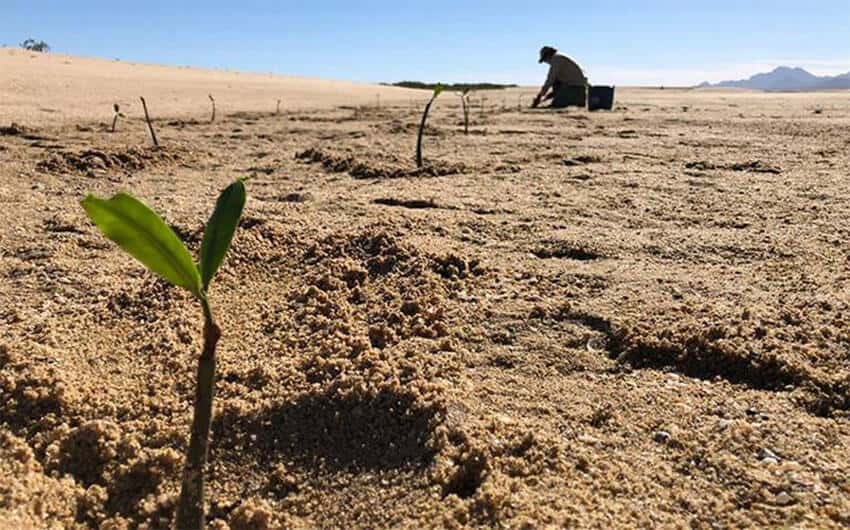Many mangrove forests have been damaged or threatened by tourism and industrial projects, including the construction of Pemex’s new refinery on the Tabasco coast, but pristine mangrove swamps located between the Sonora coast and Mexico’s largest island are still intact and growing thanks to the conservation efforts of a group of indigenous Comcaac people.
The Canal del Infiernillo – a channel between the southern Sonora coast and Isla Tiburón with mangrove estuaries, seagrass beds, seasonal creeks and small coral reef patches – was designated a wetland of international importance in 2009.
It is currently one of 142 sites in Mexico that have been designated as such in accordance with the Ramsar Convention on Wetlands of International Importance, an international treaty signed in 1971.
For mangrove forests in the coastal waters of the Gulf of California – located between the Mexican mainland and the Baja California Peninsula – dragnet fishing, furtive hunting for species such as sea turtles, illegal tourism and climate change are all threats, according to a report by the environmental news website Mongabay.
But the mangroves between the Comcaac, or Seri, town of Punta Chueca and Isla Tiburón have not been adversely impacted by man, said Alberto Mellado, an aquaculture engineer and conservationist.
![]()
He and other indigenous residents of southern Sonora are committed to maintaining that status quo while helping to increase the size of mangrove forests off the coast of Isla Tiburón, a 1,200-square-kilometer island with a human population of zero.
“Strangely and stupidly, man has … destroyed mangroves all over the world but here [we have] the last virgin ones in the northwest of Mexico,” Mellado told Mongabay.
“We’re still conserving 862 hectares of intact mangrove forest; they’re the northernmost mangroves and the most fragile in the entire continent,” Mellado said.
Along with his wife Erika Barnett, the Comcaac man put together an eight-person team dedicated to the protection and growth of mangroves and sea grasses in the Canal del Infiernillo, inhabited by scores of marine animals, including threatened sea turtle species.
The team’s work – which is not only a lifeline for endangered marine animals but also helps combat climate change – is supported by the Borderlands Restoration Network (BRM), a United States-based conservation organization.
“Mangroves are an important species [in the fight] against climate change,” Mellado said.

“They’re a natural breeding ground … where life happens and species reproduce. They’re like nurseries of the sea, … that’s where their importance comes from. They reduce the intensity of swells during storms, they reduce the intensity of wind. People who live near mangroves are more protected – they’re biophysical barriers,” he said.
To ensure the ongoing health of mangrove forests off the coast of southern Sonora, the team led by Mellado recently planted 4,200 seedlings. The mangroves were grown in a nursery built at his home with money provided by the team members themselves as well as funding from the BRM.
“The project begins with the collection of seedlings from the mangroves in August. They’re known as ‘seeds’ but they’re not, … mangroves are viviparous [life-bearing] plants and what emerges is a seedling almost ready to become a tree, it just needs a place where it can take root and establish itself,” Mellado said.
Once the seedlings have developed they are replanted in the ecosystem from which they they were taken. The 4,200 plants were reintroduced to the Canal del Infiernillo late last year.
“Recent research shows that mangroves and seagrasses … store more carbon that any land ecosystem so their conservation and restoration are recognized as strategies for the mitigation … of climate change,” said Laura Monti, a cultural ecologist and BRM board member.
“The Ramsar protected area within the Canal del Infiernillo is about 30,000 hectares and seagrass covers 9,725 hectares – in other words more than in any other place on the entire Pacific side of Mexico,” said Gary Nabhan, a noted agricultural ecologist and ethnobotanist who collaborates with the BRM.
“It captures approximately 46,000 tonnes of carbon per year; that’s more than in any place in the Gulf [of California]. The blue carbon capture of sea plants is greater per hectare than the majority of … forests and jungles on land,” he said.
Despite the immense benefits generated by the conservation of mangroves and seagrasses, the Mexican government hasn’t supported Mellado’s initiative.
“The National Forest Commission doesn’t consider mangroves as forest species … [worthy] of support for community work,” he said.
The conservationist said the lack of government support has prevented his team from undertaking its project on a larger scale. He said they and other environmental groups are unable to access the funding they need to carry out projects on a scale that would “truly provoke a transformation in the environment.”
While the Comcaac people’s guardianship of the mangroves in their ancestral waters is undoubtedly invaluable, the impact of replanting 4,000 mangroves per year is only “minor,” Mellado said.
With reports from Mongabay
